The George Cross (GC) is the highest award bestowed by the British government for non-operational gallantry or gallantry not in the presence of an enemy. In the British honours system, the George Cross, since its introduction in 1940, has been equal in stature to the Victoria Cross, the highest military gallantry award. It is awarded "for acts of the greatest heroism or for most conspicuous courage in circumstance of extreme danger", not in the presence of the enemy, to members of the British armed forces and to British civilians. Posthumous awards have been allowed since it was instituted. It was previously awarded to residents of Commonwealth countries, most of which have since established their own honours systems and no longer recommend British honours. It may be awarded to a person of any military rank in any service and to civilians including police, emergency services and merchant seamen. Many of the awards have been personally presented by the British monarch to recipients or, in the case of posthumous awards, to next of kin. The investitures are usually held at Buckingham Palace.

The Tower Hill Memorial is a pair of Commonwealth War Graves Commission memorials in Trinity Square Gardens, on Tower Hill in London, England. The memorials, one for the First World War and one for the Second, commemorate civilian, merchant seafarers and fishermen who were killed as a result of enemy action and have no known grave. The first, the Mercantile Marine War Memorial, was designed by Sir Edwin Lutyens and unveiled in 1928; the second, the Merchant Seamen's Memorial, was designed by Sir Edward Maufe and unveiled in 1955. A third memorial, commemorating merchant seamen who were killed in the 1982 Falklands War, was added to the site in 2005.
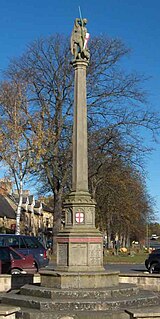
Moreton-in-Marsh and Batsford War Memorial stands in Moreton-in-Marsh, Gloucestershire, England, and is a memorial to those of Moreton and Batsford killed in the First and Second World Wars. The erection of the memorial on the High Street began in November 1920. It is built of Hollington stone from Staffordshire, and stands 24 feet (7.3 m) high. The work was carried out by R. I. Boulton and Sons of Cheltenham to Guy Dawber's design. Carved at the top of the memorial are the figures of St. George and the Dragon from the model prepared by the sculptor, Allan Wyon of London. The total cost was around £700, raised primarily from public subscriptions.

The Polish Air Force Memorial is a war memorial in West London, England in memory of airmen from Poland who served in the Royal Air Force as part of the Polish contribution to World War II. Over 18,000 men and women served in the Polish squadrons of the RAF during the war, and over 2,000 lost their lives. The memorial marks the southern extremity of South Ruislip in the London Borough of Hillingdon, near RAF Northolt, where seven Polish-manned fighter squadrons were based at different times in the war.
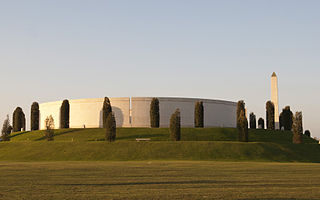
The Armed Forces Memorial is a national memorial in the United Kingdom, dedicated to the 16,000 servicemen and women of the British Armed Forces killed on duty or through terrorist action since after the Second World War. It is within the National Memorial Arboretum in Staffordshire.

The La Ferté-sous-Jouarre memorial is a World War I memorial in France, located on the south bank of the river Marne, on the outskirts of the commune of La Ferté-sous-Jouarre, 66 kilometres east of Paris, in the department of Seine-et-Marne. Also known as the Memorial to the Missing of the Marne, it commemorates over 3,700 British and Irish soldiers with no known grave, who fell in battle in this area in August, September and early October 1914. The soldiers were part of the British Expeditionary Force, and are listed on the memorial by regiment, rank and then alphabetically.

The Victoria Cross (VC) is the highest and most prestigious award of the British honours system. It is awarded for valour "in the presence of the enemy" to members of the British Armed Forces and may be awarded posthumously. It was previously awarded by countries of the Commonwealth of Nations, most of which have established their own honours systems and no longer recommend British honours. It may be awarded to a person of any military rank in any service and to civilians under military command. No civilian has received the award since 1879. Since the first awards were presented by Queen Victoria in 1857, two-thirds of all awards have been personally presented by the British monarch. The investitures are usually held at Buckingham Palace.
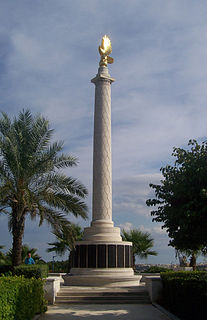
The Malta Memorial is a war memorial monument to the 2,298 Commonwealth aircrew who lost their lives in the various Second World War air battles and engagements around the Mediterranean, whilst serving with the Commonwealth Air Forces flying from bases in Austria, Italy, Sicily, islands of the Adriatic and Mediterranean, Malta, Tunisia, Algeria, Morocco, West Africa, Yugoslavia and Gibraltar, and who have no known grave.

The Australian War Memorial in London is a memorial dedicated in 2003 to the 102,000 Australian dead of the First and Second World Wars. It is located on the southernmost corner of Hyde Park Corner, on the traffic island that also houses the Wellington Arch, the New Zealand War Memorial, the Machine Gun Corps Memorial and the Royal Artillery Memorial.

The North Front Cemetery is a cemetery located in the British Overseas Territory of Gibraltar. Also known as the Gibraltar Cemetery and the Garrison Cemetery, it is the only graveyard still in use in Gibraltar. It is also the only Commonwealth War Graves Commission (CWGC) cemetery in Gibraltar. The two CWGC monuments, the Gibraltar Memorial and the Gibraltar Cross of Sacrifice, are positioned nearby at the junction of Winston Churchill Avenue and Devil's Tower Road.

The Gibraltar Cross of Sacrifice is a war memorial in the British Overseas Territory of Gibraltar. It is located west of North Front Cemetery, at the junction of Winston Churchill Avenue and Devil's Tower Road. The Cross of Sacrifice was designed by Sir Reginald Blomfield in 1917, and his monument is found in numerous Commonwealth War Graves Commission cemeteries. The cross in Gibraltar was erected by the Royal Engineers for the commission, and unveiled on Armistice Day 1922. The British Pathé film recorded at the dedication ceremony that day represents the first motion picture made in Gibraltar. The Gibraltar Cross of Sacrifice served as the focus of Remembrance Sunday ceremonies in Gibraltar until 2009, at which time the location was changed to the Gibraltar War Memorial.
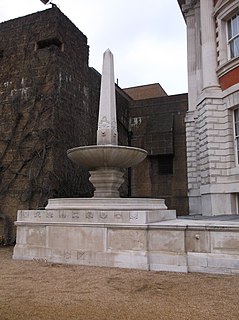
The Royal Naval Division Memorial is a First World War memorial located on Horse Guards Parade in central London, and dedicated to members of the 63rd Division (RND) killed in that conflict. Sir Edwin Lutyens designed the memorial, which was unveiled on 25 April 1925—ten years to the day after the Gallipoli landings, in which the division suffered heavy casualties. Shortly after the war, former members of the division established a committee, chaired by one of their leading officers, Brigadier-General Arthur Asquith, to raise funds for a memorial. Progress was initially slow. The committee planned to incorporate its memorial into a larger monument proposed by the Royal Navy for Trafalgar Square. When the navy abandoned that project, the RND's committee decided to proceed independently. They engaged Lutyens, who, after negotiation with the Office of Works, produced a design for a fountain connected to the balustrade of the Admiralty Extension building.

Kohima War Cemetery is a memorial dedicated to soldiers of the 2nd British Division of the Allied Forces who died in the Second World War at Kohima, the capital of the Indian state of Nagaland in April 1944. The soldiers died on the battleground of Garrison Hill in the tennis court area of the Deputy Commissioner's residence. According to the Commonwealth War Graves Commission, which maintains this cemetery among many others in the world, there are 1,420 Commonwealth burials of the Second World War at this cemetery, and a memorial to an additional 917 Hindu and Sikh soldiers who were cremated in accordance with their faith. The memorial was inaugurated by Field Marshal Sir William Slim, then Commander of the 14th Army in Burma.

The Liverpool Naval Memorial, also known as the Memorial to the Missing of the Naval Auxiliary Personnel of the Second World War or the Merchant Navy War Memorial, is a war memorial at Pier Head beside the River Mersey in Liverpool, near to the Royal Liver Building and the Museum of Liverpool. It commemorates nearly 1,400 men from the British Merchant Navy who died on active service with Royal Navy in the Second World War, and who have no known grave.
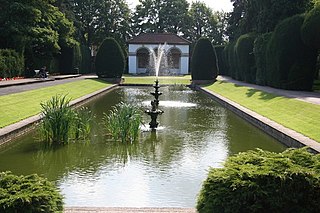
Spalding War Memorial is a First World War memorial in the gardens of Ayscoughfee Hall in Spalding, Lincolnshire, in eastern England. It was designed by the architect Sir Edwin Lutyens. The proposal for a memorial to Spalding's war dead originated in January 1918 with Barbara McLaren, whose husband and the town's Member of Parliament, Francis McLaren, was killed in a flying accident during the war. She engaged Lutyens via a family connection and the architect produced a plan for a grand memorial cloister surrounding a circular pond, in the middle of which would be a cross. The memorial was to be built in the formal gardens of Ayscoughfee Hall, which was owned by the local district council. When McLaren approached the council with her proposal, it generated considerable debate within the community and several alternative schemes were suggested. After a public meeting and a vote in 1919, a reduced-scale version of McLaren's proposal emerged as the preferred option, in conjunction with a clock on the town's corn exchange building.

The Royal Tank Regiment Memorial is a sculpture by Vivien Mallock in Whitehall Court, London. It commemorates the Royal Tank Regiment.

The Doiran Memorial is a Commonwealth War Graves Commission war memorial that is both a battlefield memorial and a memorial to the missing. It honours the dead of the British Salonika Force as well as commemorating by name the 2171 missing dead of that force who fell in fighting on the Macedonian front during the First World War in the period 1915–1918.
The George Cross Island Association is a charitable organisation that was initiated to honour and remember those that suffered during the Siege of Malta . The association has branches across the UK and a branch in Malta. The Patron of the G.C.I.A. is The Duke of Edinburgh, KG, KT, Prince Philip who himself served in Malta.

The Equestrian statue of Ferdinand Foch stands in Lower Grosvenor Gardens, London. The sculptor was Georges Malissard and the statue is a replica of another raised in Cassel, France. Foch, appointed Supreme Commander of the Allied Forces on the Western Front in the Spring of 1918, was widely seen as the architect of Germany's ultimate defeat and surrender in November 1918. Among many other honours, he was made an honorary Field marshal in the British Army, the only French military commander to receive such a distinction. Following Foch's death in March 1929, a campaign was launched to erect a statue in London in his memory. The Foch Memorial Committee chose Malissard as the sculptor, who produced a replica of his 1928 statue of Foch at Cassel. The statue was unveiled by the Prince of Wales on 5 June 1930. Designated a Grade II listed structure in 1958, the statue's status was raised to Grade II* in 2016.

















